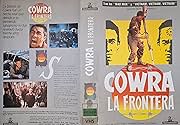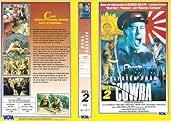Aggiungi una trama nella tua linguaAugust 1944, Cowra Australian POW camp. 1,104 Japanese prisoners stage a mass breakout, leaving 4 guards dead. 231 prisoners die from wounds or suicide, while 334 are recaptured within 9 day... Leggi tuttoAugust 1944, Cowra Australian POW camp. 1,104 Japanese prisoners stage a mass breakout, leaving 4 guards dead. 231 prisoners die from wounds or suicide, while 334 are recaptured within 9 days.August 1944, Cowra Australian POW camp. 1,104 Japanese prisoners stage a mass breakout, leaving 4 guards dead. 231 prisoners die from wounds or suicide, while 334 are recaptured within 9 days.
Sfoglia gli episodi
Recensioni in evidenza
This is one of my favourite mini-series. It is a shame that "Cowra Breakout","The Dirtwater Dynasty" and "Against the Wind' are not put back on Television and/or DVD. All of these are very well acted, very Australian and keeps myself as a viewer,very absorbed. From memory the Cowra Breakout is set during the 2nd world war, in which our two main protaganists meet, during a very bitter battle which I think results in the capture of the japanese actor and the returning of the aussie to a N.S.W town called Cowra. The Japanese are kept as prisoners in POW there camp and our two former enemies become friends. To be captured by the enemy is to be absolutely disgraced and the only honorable thing for a Japanese POW to do is to committ suicide, which some of them try. All in all a very good mini-series with good flow and one which I believe, would be enjoyed by the rest of the world
I watched this miniseries many times in the 80s and knew it well. I have purchased several copies of versions supposedly with different run times but they both have many scenes and characters edited out. For example scenes containing Peter Phelps and Donal Gibson (Blackjack) are missing.
I can only imagine this is due to political correctness due to their (what may now be considered offensive) comments and actions. There have been other scenes missing as well.
The original was very good. This version is watchable but you feel very shortchanged if you know the original. Don't be fooled by the different dvd version listed run times, they appear to be the same and are heavily edited. I found out the hard way.
I can only imagine this is due to political correctness due to their (what may now be considered offensive) comments and actions. There have been other scenes missing as well.
The original was very good. This version is watchable but you feel very shortchanged if you know the original. Don't be fooled by the different dvd version listed run times, they appear to be the same and are heavily edited. I found out the hard way.
For all that it could have been, this movie is a failure. It fails to adequately explore prisoner motivations or experience or provide a corporate insight into how war time Australia felt or behaved.
August 5 1944, over two years since a break out at Featherstone NZ led to increased security, over 545 Japanese soldiers stormed a machine gun nest and wandered around outback NSW before surrendering. An estimated 234 died and 108 were wounded.
Historian Gavin Long recorded "At about 2 a.m. a Japanese ran to the camp gates and shouted what seemed to be a warning to the sentries. Then a Japanese bugle sounded. A sentry fired a warning shot. More sentries fired as three mobs of prisoners, shouting "Banzai", began breaking through the wire, one mob on the northern side, one on the western and one on the southern. They flung themselves across the wire with the help of blankets. They were armed with knives, baseball bats, clubs studded with nails and hooks, wire stilettos and garroting cords"
The authorities had been tipped off regarding the outbreak, and the Japanese were to be transported to Hay when they fled.
Japanese soldiers were unlikely to have committed ritual suicide over the disgrace of capture, rather, they had been told to expect torture and camp conditions equivalent to Allied detainees in Burma etc. It is known that treatment of Japanese (Italian and German) prisoners had been humane. It is possible individual events might not uniformly express the humanity .. machine gunning the breakout was not the finest moment in Australian History of detainment.
August 5 1944, over two years since a break out at Featherstone NZ led to increased security, over 545 Japanese soldiers stormed a machine gun nest and wandered around outback NSW before surrendering. An estimated 234 died and 108 were wounded.
Historian Gavin Long recorded "At about 2 a.m. a Japanese ran to the camp gates and shouted what seemed to be a warning to the sentries. Then a Japanese bugle sounded. A sentry fired a warning shot. More sentries fired as three mobs of prisoners, shouting "Banzai", began breaking through the wire, one mob on the northern side, one on the western and one on the southern. They flung themselves across the wire with the help of blankets. They were armed with knives, baseball bats, clubs studded with nails and hooks, wire stilettos and garroting cords"
The authorities had been tipped off regarding the outbreak, and the Japanese were to be transported to Hay when they fled.
Japanese soldiers were unlikely to have committed ritual suicide over the disgrace of capture, rather, they had been told to expect torture and camp conditions equivalent to Allied detainees in Burma etc. It is known that treatment of Japanese (Italian and German) prisoners had been humane. It is possible individual events might not uniformly express the humanity .. machine gunning the breakout was not the finest moment in Australian History of detainment.
Lo sapevi?
- QuizThis mini-series' closing epilogue states: "On 2nd March 1946, the Japanese ship Daikai Maru steamed out of Sydney Harbour carrying the surviving Cowra prisoners. Three weeks late they disembarked onto an empty wharf in Japan and disappeared into Japanese society. Many have never told their friends, their wives or their children that they were prisoners-of-war [POWs]. Today the 4 Australians and 231 Japanese who died in the breakout lie buried in the War Cemetery at Cowra. In [a] field nearby, cattle graze amongst the ruins of the [Cowra Word War II] Prisoner-of-War Camp."
- ConnessioniReferenced in Cast & Crew Interviews (2001)
I più visti
Accedi per valutare e creare un elenco di titoli salvati per ottenere consigli personalizzati
Dettagli
Contribuisci a questa pagina
Suggerisci una modifica o aggiungi i contenuti mancanti

Divario superiore
By what name was The Cowra Breakout (1984) officially released in Canada in English?
Rispondi




















